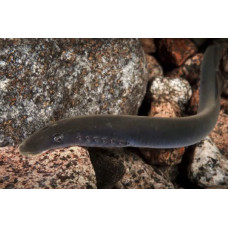Cyclostomata - primitive vertebrates (lampreys and hagfish). The jaws are absent, the mouth is in the form of a suction cup. The axial skeleton is represented by chordae. Respiratory organs - 5-16 pairs of gill sacs. They live in the sea, in estuaries and rivers. Most Roundworms are parasites and predators.
Includes lampreys and hagfish, thus encompassing all modern pinnipeds. As of 2016, 118 modern species are known (40 lamprey species and 78 hagfish species).
Previously, roundworms were considered as a class, and lampreys and hagfishes as subdivisions. However, some morphological studies indicated that lampreys are more closely related to jawfish than to hagfishes, and thus Cyclostomata is a paraphyletic group. This version was widely disseminated, and lampreys and hagfish began to be assigned to different classes and sometimes infratypes. In a number of subsequent works these results were recognized as incorrect, and morphological data - not allowing to make a choice between paraphyletic and monophyletic roundworms. Molecular data suggest that they are monophyletic.
Cyclostomata are distinguished from fishes and the quadrupeds descended from them by the following features:
no scales;
no paired limbs;
chordae persist throughout life, but there are cartilaginous rudiments of the upper vertebral arches along the chordae;
cartilaginous skull without jaws;
oval or round mouth, provided with suction structures and epidermal teeth.
Their dorsal string, owing to the formation of cartilage, has acquired a greater hardness than the chorda of lancemannids, and also has the rudiments of vertebrae, but the true spine is not yet developed. A small brain, comparable in volume to the brain of fish, is protected by a cartilaginous-skin skull. The organ of olfaction is the seven orifices located between the eyes. Despite the narrow fins, Cyclostomata are able to move quickly in the water. Their specialty is the ability to "suckle" on fish and use them to move around. Their food includes worms, insects and fish eggs. Some Cyclostomata are semi-parasites.
They have serpentine elongated, naked body reaching 40 cm in length. In the body distinguish 3 sections: head, trunk and tail, and these sections pass into each other gradually. Paired limbs are absent. On the dorsal side are clearly visible 2 leathery unpaired fins, the last of which passes directly into the caudal fin. The head is small, the mouth opening is located at the bottom of the suction funnel, bordered by dermal petals. On the inner wall of the suction funnel sit "horny teeth". The tip of the tongue, which is usually clearly visible in the mouth opening, also has horny plates bearing small "horny teeth". The tongue is powerful, boring, and equipped with a skeleton. Gill skeleton has the form of an openwork lattice or basket, not dissected into separate gill arches. The skeleton of roundworms is formed by cartilage and connective tissue, there is no bone tissue in the skeleton. The olfactory organ, in contrast to similar organs of all other vertebrates, is unpaired. It opens at the anterior end of the snout with a single nostril leading into the olfactory sac, from the bottom of which a peculiar pituitary outgrowth, located between the anterior part of the brain and the palate, branches off.
Cyclostomata wait for prey; having detected it with the help of sensory organs, seek to approach and attach themselves. Before spawning, they stop feeding and migrate to spawning grounds. In this case, sea lampreys enter pre-spawning areas and lower reaches of rivers, and some go far upstream. River lampreys make only small movements. Spawning ends the life cycle of most lamprey species.
Cyclostomata
Tags: cyclostomata


